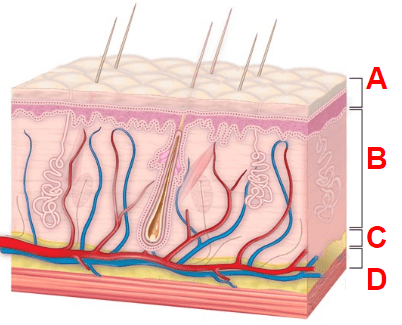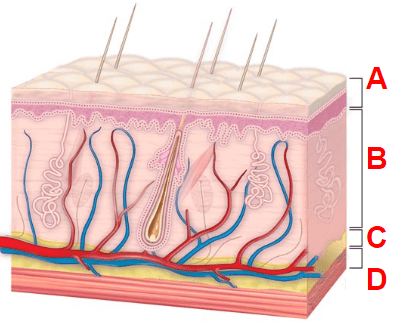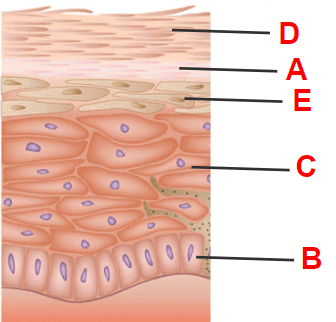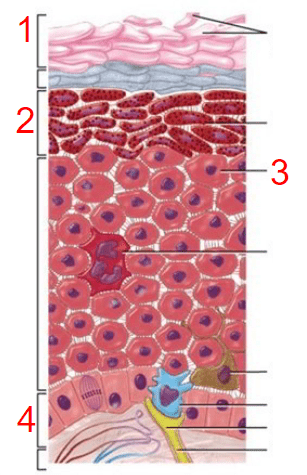This type of gland becomes active during puberty and is found in the axillary and anogenital regions.
What is an Apocrine Gland?
This is the most common form of skin cancer which deals with UV radiation damage to DNA in basal cells.
What is Basal Cell Carcinoma?
This is the layer of skin that is composed of keratinized tissue.
What is the Epidermis?
This is the outermost layer of the skin.
What is the Epidermis?
The Rule of Nines is used in this type of injury.
What are Burns?
Identify the Structures:

Identify the Structures:

A - Epidermis
B - Dermis
C - Hypodermis/Subcutaneous
D - Muscle
The skin accounts for around this % of a person's body weight.
~ 15%
This type of gland secretes oil onto hair and skin.
What is a Sebaceous Gland?
This type of skin cancer metastasizes rapidly and can kill within months.
What is Malignant Melanoma?
Name the three layers of the skin from top (surface) to bottom (deep).
Epidermis
Dermis
Hypodermis/Subcutaneous
This is the second layer of skin, sitting between the other two layers.
What is the Dermis?
This type of burn reaches the Epidermis, does not blister, and usually doesn't impact hair growth, temperature regulation, or nerve damage.
What is a First Degree Burn?
This is the Degree of Burn is pictured below. Also explain HOW YOU KNOW.

What is a Second Degree Burn?
NASTY BLISTERS
If you took off an average person's skin, it would cover about ____ square meters.
What is 2 square meters?
This is the portion of hair that is responsible for its growth.
What is the Matrix?
This is the skin condition in which there is a loss of melanocytes in patches of the skin, which produces white spots.
What is Vitiligo?
This epidermal layer is only found in the hands and feet.
What is the Stratum Lucidum?
This is the layer that provides blood and nourishment to the basal layer of cells in the epidermis.
What is the Papillary Layer?
Most burn victims die when the burn exceeds ____% of the body.
What is 50%?
Identify Each Layer:

D: Stratum Corneum
A: Stratum Stratum Lucidum
E: Stratum Granulosum
C: Stratum Spinosum
B: Stratum Basal
One square inch of skin is made up of ____ million skin cells.
What is 19 million?
This is a substance produced by sebaceous glands that are, in most cases, attached to hair follicles.
What is Sebum?
This chemical contributes to the color of skin and absorbs UV light.
What is Melanin?
This is the layer of skin that is mainly composed of dense irregular connective tissue.
What is the Reticular layer of the Dermis?
This is the deepest layer that is associated with the skin.
What is the Hypodermis and/or Subcutaneous?
This type of burn is characterized by presence of blisters, nerve damage, probable hair loss, and unlikely retention of temperature regulation.
What is a Second Degree Burn?
Identify Structures 10, 11, 12:

10 - Eccrine (or Apocrine in pits, genitals... puberty stuff) Sweat Glands
11 - Sebaceous Glands
12 - Hair Bulb/Hair Follicle
The skin contains ____ miles of blood vessels.
What is 11 miles?
Most of the cells in your skin are this type of variety.
What are Keratinocytes?
DAILY DOUBLE: Write your wager above your answer. YOU ONLY GET ONE GUESS.
List the ABCDEs of Skin Cancer Detection.
Asymmetry
Border Irregularity
Color
Diameter
Evolving
Adipose tissue and skeletal muscle are the two main tissue types of this layer of the skin.
What is the Hypodermis?
Name the 4 layers of the Epidermis that are found throughout the body, starting from the deepest layer.
Basal
Spinosum
Granulosum
Corneum
This type of burn reaches through to the Hypodermis/Subcutaneous Layer, does not have blisters (because they're probably popped/burst from heat), and has a heavy impact upon hair growth, temperature regulation, and nerve damage.
What is a Third Degree Burn?
Identify the Structures:


1 - Stratum Corneum
2 - Stratum Granulosum
3 - Keratinocyte
4 - Stratum Basale
What is about 9 lbs./year?